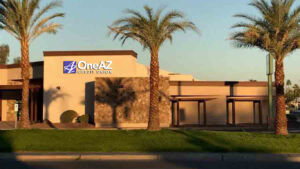It’s an afternoon scene, two students are sitting side-by-side on the sidewalk of a fast-food restaurant parking lot pounding away at their homework on laptops.
“No student should have to do this. This isn’t right,” said Christine Mackay, director, Phoenix Community and Economic Development. “I knew that we had a problem with the digital divide in Phoenix that needed to be solved, but how to do so. Then Dr. (Larry) Johnson (president of Phoenix College) called.”
In a city becoming one of the innovation hotbeds for technology companies, a break-the-mold request for proposals is on the street to bridge the digital divide today. A technology company or collaborative considering itself nimble, innovative, and entrepreneurial will deliver the future to digitally underserved Phoenix students and create the foundation for the workforce of the future.
They’ll have to work rapidly to be considered. The proposal is due to Phoenix Union High School District on November 24.
“We needed to bring everyone together to collaborate on a solution,” said Larry Johnson, Ph.D., president, Phoenix College. “When the pandemic hit, it placed a burden on our most vulnerable students. Many of these students did not have internet access outside of school.”
The solution brings broadband direct-to-school intranet access to those vulnerable students’ homes instead of hotspot access points—whether it be a library parking lot or the curb at a fast-food joint.
“The beauty of this is that we are better finding solutions together,” said Johnson. “We wanted to increase opportunities for our most vulnerable students. (Bridging the digital divide) is a clarion call for social justice that provides equality of (information) access.”
It is a challenge for students in some areas of Phoenix to find internet access, let alone connect with adequate speed and bandwidth to complete homework. This digital divide holds back young students who need that access the most. The program is a step to close the gap between those vulnerable students without access to computers or broadband internet and those that do.
Phoenix distributed 800 tablets to students in public housing earlier this year to attend virtual classrooms, but many still couldn’t get connected at home.
“The digital divide has always been a problem, and I’ve wanted to find a solution. Then Covid-19 hit, and what was a theoretical problem became a real-life imperative. Kids couldn’t get to school, and we had to do something,” said Councilwoman Laura Pastor, Phoenix District 4. “With the time and resources at hand, right now was the time to solve the problem. We filled every seat at the table with people dedicated to solutions.”
Johnson added, “We’re closing the digital divide for the students who need it most.”
The RFP wants the successful proposer to take the working micro proof of concept (POC) and scaleup to provide secured home-to-classroom intranet connections. Public internet access is not part of the plan, so that traditional broadband access remains with commercial internet service providers. According to Pastor, some ISPs offer low-cost internet access to income-challenged families, but it isn’t a complete solution.
“A more direct connection is needed for virtual classes,” she said. “With these families disproportionally hit by furloughs, layoffs and closures, even the low cost can be a hardship. We had to do something for home access, not outlying hot spots.”
The challenge combined solution-generating discussions involving the city, Phoenix College, Phoenix Union High School District and all the elementary schools feeding PUHSD campuses. Some temporary relief came to be when the school districts started putting hotspots on buses and moving through blacked out neighborhoods. The city of Phoenix helped by delivering public Wi-Fi coverage at nearly 50 libraries and senior and recreation centers. The city sites give students a safe and secure place to connect to the internet for school, but they still can’t work at home. The collaboration upped the ante: bring that secure school-only access directly into homes.
“This is an opportunity for a company that thinks outside the box and is flexible in its approach to finding next-generation solutions,” said Mackay. “I know the turn-around time is tight on this RFP, but for innovators, it’s a chance to refine and scale a solution that opens broad opportunities in Phoenix or anywhere.”
“Our technology team at Phoenix College has been driving around in golf carts testing (the micro POC) signal strength. The concept is working. We need help scaling up,” Johnson said. “This is a chance for students to learn and to have experience for a higher-than-poverty wage job.”
Johnson said that Phoenix College is turning the program into a learning opportunity by connecting it with a micro-credential, certifying students with the education and experience to install the public-access software and hardware bringing education into communities everywhere.
The successful proposer will analyze the micro POC and test results and redeploy the same or create a more successful solution to scale up the POC testing to a quarter section—one square quarter-mile—in a Phoenix school district.
“This is about jobs,” said Pastor. “About jobs and the future workforce that Phoenix companies tell us that they need.”
Another goal of the PUHSD RFP is to build out a full test covering four square miles in two elementary school districts using the same protocol and setup as the quarter-mile test working.
“Closing the digital divide is not a one-time project; it’s readying a system to be scaled up,” Johnson said.
Bringing a solution to reality with multiple public partners usually brings visions of progress blocked by silos, floundering in red tape and stopped by barriers.
“Not so with this group,” said Pastor. “The synergy of a group committed to finding solutions was so strong; we just knew we were going to find a solution. We are solving a real challenge for our students.”
“The collaboration of all parties has a collective impact from this program,” said Johnson. “We’ve come up with a plan that has long-term impacts on their lives.”
“I’m a teacher at heart. Solving problems is what we do,” Pastor added. “Our collective energy meant that we kept pushing this forward. We kept moving it forward with all sharing a single vision of staying within the boundaries of what we could afford.”
The proposals for “Network of the Future for a Workforce of the Future – Bridging the Digital Divide,” Phoenix Union High School RFP #9-1120, are due by 2:00 p.m., Mountain Standard Time, Tuesday, November 24. Copies of the RFP can be downloaded from AZPurchasing.org. For more information, only contact Lila McCleery, director, Purchasing, Supply and Property, Phoenix Union High School District. McCleery@PhoenixUnion.org.
The successful proposer is gaining more than just a project to add to its accomplishments. According to Johnson, “This is a moment in time where a company does something that makes a real difference in people’s lives. It’s part of a social justice moment.”



